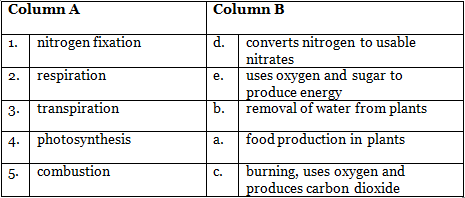Textbook Solutions: Air Around Us. | Eureka Plus Class 6: Book Solutions, Notes & Worksheets PDF Download
I.
Q. Write the meanings of the following terms.
Ans:
1. Atmosphere: The layer of air surrounding the Earth.
2. Nitrogen fixation: The natural process that uses atmospheric nitrogen to form nitrogen-rich substances, like nitrates, that plants can use.
3. Air pollutant: Substances produced by human activities, such as from automobiles and industries, that spoil the quality of air.
4. Respiration: The process of breathing in air, absorbing oxygen, and using it to release energy from sugar.
5. Combustion: The process of burning things, which involves using oxygen.
6. Transpiration: The process by which plants release water vapor into the air through tiny pores on their leaves.
II. Answer the following questions in one sentence.
1.
Ans: The atmosphere extends up to about 600 km above the Earth's surface.
2.
Ans: The components of air are nitrogen, oxygen, carbon dioxide, water vapor, argon, and neon gases.
3.
Ans: The layer of ozone gas is present in the upper region of the Earth's atmosphere.
4.
Ans: Ozone is a form of oxygen.
5.
Ans: Ozone is a form of oxygen.
6.
Ans: Nitrogen gas is present in the air in the largest amount (78%).
7.
Ans: Plants make proteins by using nitrates.
III.
1.
Ans:

IV. Answer the following questions in two to three sentences.
1.
Ans: There is less air in the higher regions of mountains because, as you move upwards, the air gradually becomes thinner.
2.
Ans: The amount of carbon dioxide in the air does not increase significantly because plants and plant-like microorganisms use carbon dioxide during photosynthesis to make their own food.
3.
Ans: Respiration by animals uses oxygen and produces carbon dioxide, while photosynthesis by plants uses carbon dioxide and produces oxygen, thus maintaining a balance in the amounts of both gases in the air.
4.
Ans: Uses of air include regulating temperature, protecting life through the ozone layer, dispersing pollen grains and seeds, being a source of energy, and various practical applications like inflating balls and operating musical instruments.
5.
Ans: Wind is a source of energy because it can be harnessed to operate windmills, which are used for drawing water, grinding flour, and generating electricity.
Think and answer
1.
Ans: The tree is asking for our CO2 (carbon dioxide) because it uses this gas in the process of photosynthesis. The tree will absorb the CO2 and, using the energy from sunlight, will convert it into glucose and oxygen. The oxygen is then released into the atmosphere, which is essential for human and animal respiration.
2.
Ans: In exchange for CO2, the tree wishes to give us oxygen. This is the oxygen that we breathe in, which is essential for our survival. It's the byproduct of the photosynthesis process, during which the tree converts CO2 and water into glucose and releases oxygen.
3.
Ans: The tree suggests that if it is cut down, it will no longer be able to produce oxygen, which both humans and trees rely on for respiration. Without trees to convert CO2 into oxygen, the amount of breathable air will decrease, adversely affecting all aerobic life forms.
4.
Ans:
Don’t chop me down, my leaves so green, Making air that you can breathe
This line emphasizes the tree's role in purifying the air. The green leaves signify the tree's health and its ability to perform photosynthesis, which produces the clean air we need to breathe.
Don’t chop me down, just leave me be, In the forest with my family.
Here, the tree is making a plea for its life and the life of other trees (its family). It highlights the importance of forests and their ecosystems, which are crucial for maintaining biodiversity, ecological balance, and the air quality of our planet.
|
22 videos|80 docs|16 tests
|
FAQs on Textbook Solutions: Air Around Us. - Eureka Plus Class 6: Book Solutions, Notes & Worksheets
| 1. What is the composition of the air around us? |  |
| 2. How does air help in the process of respiration? |  |
| 3. What is the role of air in maintaining the Earth's temperature? |  |
| 4. How does air pressure change with altitude? |  |
| 5. How does air quality affect our health? |  |
















